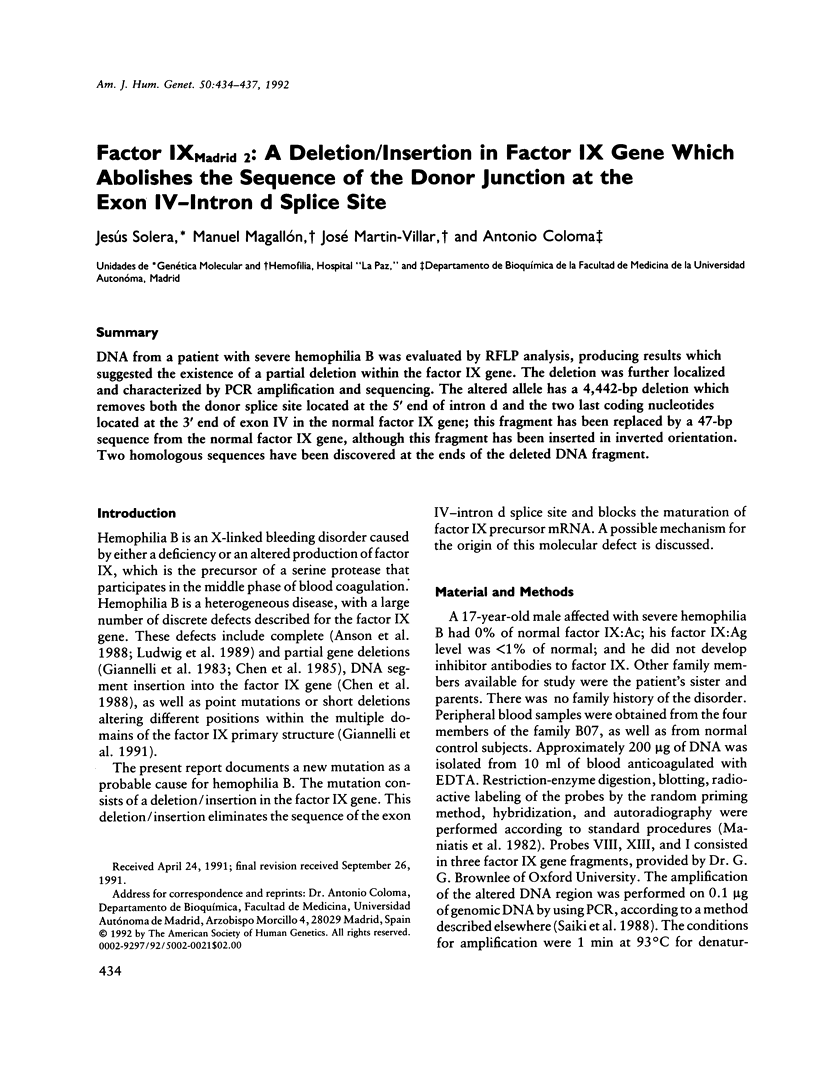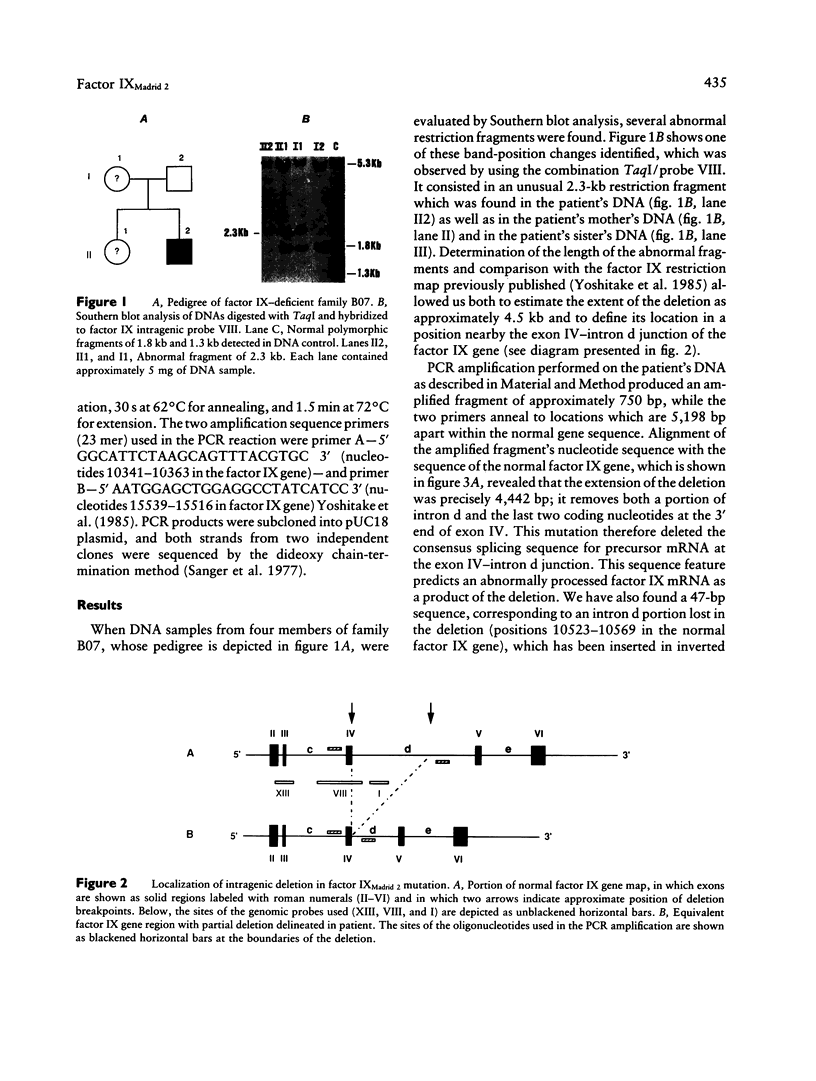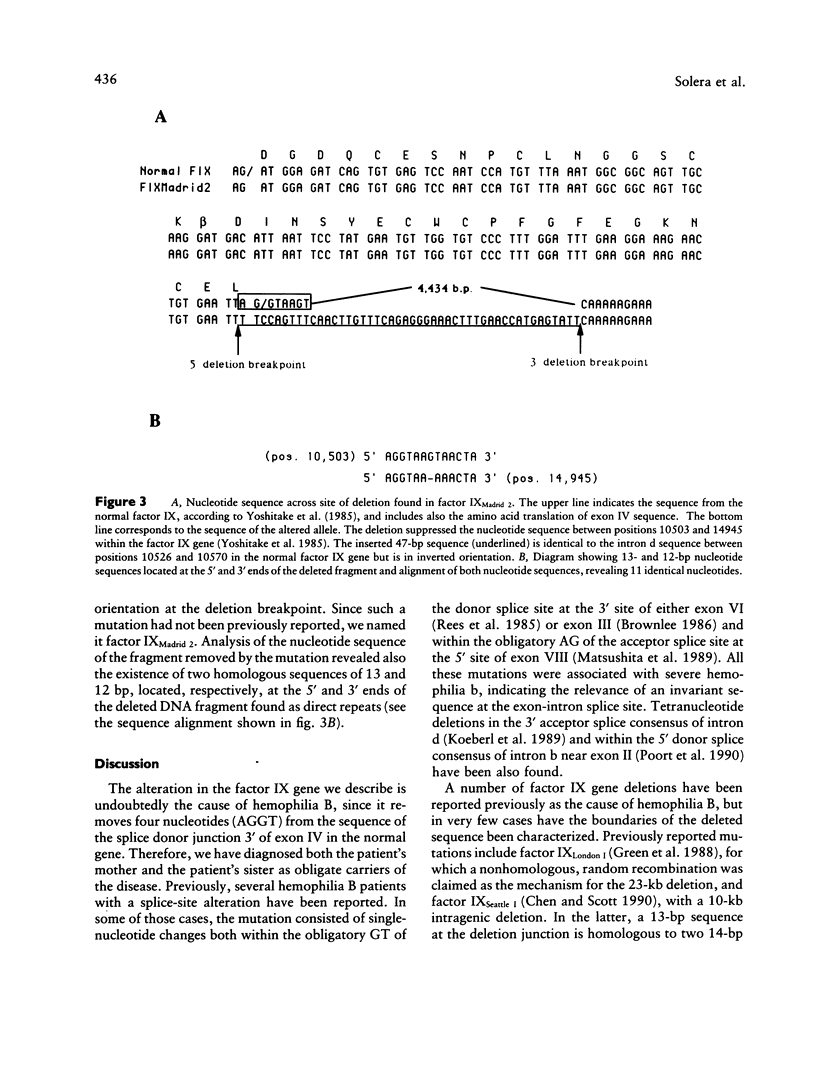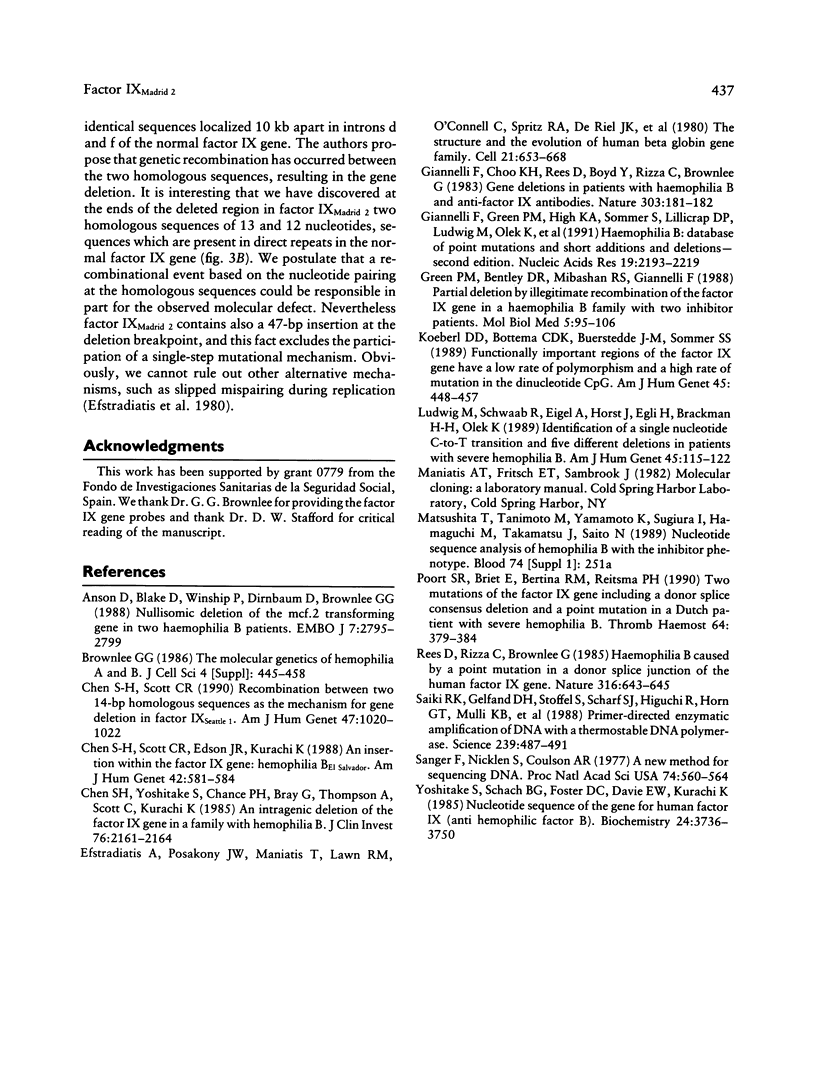Abstract
DNA from a patient with severe hemophilia B was evaluated by RFLP analysis, producing results which suggested the existence of a partial deletion within the factor IX gene. The deletion was further localized and characterized by PCR amplification and sequencing. The altered allele has a 4,442-bp deletion which removes both the donor splice site located at the 5' end of intron d and the two last coding nucleotides located at the 3' end of exon IV in the normal factor IX gene; this fragment has been replaced by a 47-bp sequence from the normal factor IX gene, although this fragment has been inserted in inverted orientation. Two homologous sequences have been discovered at the ends of the deleted DNA fragment.
Full text
PDF



Images in this article
Selected References
These references are in PubMed. This may not be the complete list of references from this article.
- Anson D. S., Blake D. J., Winship P. R., Birnbaum D., Brownlee G. G. Nullisomic deletion of the mcf.2 transforming gene in two haemophilia B patients. EMBO J. 1988 Sep;7(9):2795–2799. doi: 10.1002/j.1460-2075.1988.tb03134.x. [DOI] [PMC free article] [PubMed] [Google Scholar]
- Brownlee G. G. The molecular genetics of haemophilia A and B. J Cell Sci Suppl. 1986;4:445–458. doi: 10.1242/jcs.1986.supplement_4.24. [DOI] [PubMed] [Google Scholar]
- Chen S. H., Scott C. R., Edson J. R., Kurachi K. An insertion within the factor IX gene: hemophilia BEl Salvador. Am J Hum Genet. 1988 Apr;42(4):581–584. [PMC free article] [PubMed] [Google Scholar]
- Chen S. H., Scott C. R. Recombination between two 14-bp homologous sequences as the mechanism for gene deletion in factor IX Seattle 1. Am J Hum Genet. 1990 Dec;47(6):1020–1022. [PMC free article] [PubMed] [Google Scholar]
- Chen S. H., Yoshitake S., Chance P. F., Bray G. L., Thompson A. R., Scott C. R., Kurachi K. An intragenic deletion of the factor IX gene in a family with hemophilia B. J Clin Invest. 1985 Dec;76(6):2161–2164. doi: 10.1172/JCI112222. [DOI] [PMC free article] [PubMed] [Google Scholar]
- Efstratiadis A., Posakony J. W., Maniatis T., Lawn R. M., O'Connell C., Spritz R. A., DeRiel J. K., Forget B. G., Weissman S. M., Slightom J. L. The structure and evolution of the human beta-globin gene family. Cell. 1980 Oct;21(3):653–668. doi: 10.1016/0092-8674(80)90429-8. [DOI] [PubMed] [Google Scholar]
- Giannelli F., Choo K. H., Rees D. J., Boyd Y., Rizza C. R., Brownlee G. G. Gene deletions in patients with haemophilia B and anti-factor IX antibodies. Nature. 1983 May 12;303(5913):181–182. doi: 10.1038/303181a0. [DOI] [PubMed] [Google Scholar]
- Giannelli F., Green P. M., High K. A., Sommer S., Lillicrap D. P., Ludwig M., Olek K., Reitsma P. H., Goossens M., Yoshioka A. Haemophilia B: database of point mutations and short additions and deletions--second edition. Nucleic Acids Res. 1991 Apr 25;19 (Suppl):2193–2219. doi: 10.1093/nar/19.suppl.2193. [DOI] [PMC free article] [PubMed] [Google Scholar]
- Green P. M., Bentley D. R., Mibashan R. S., Giannelli F. Partial deletion by illegitimate recombination of the factor IX gene in a haemophilia B family with two inhibitor patients. Mol Biol Med. 1988 Apr;5(2):95–106. [PubMed] [Google Scholar]
- Koeberl D. D., Bottema C. D., Buerstedde J. M., Sommer S. S. Functionally important regions of the factor IX gene have a low rate of polymorphism and a high rate of mutation in the dinucleotide CpG. Am J Hum Genet. 1989 Sep;45(3):448–457. [PMC free article] [PubMed] [Google Scholar]
- Ludwig M., Schwaab R., Eigel A., Horst J., Egli H., Brackmann H. H., Olek K. Identification of a single nucleotide C-to-T transition and five different deletions in patients with severe hemophilia B. Am J Hum Genet. 1989 Jul;45(1):115–122. [PMC free article] [PubMed] [Google Scholar]
- Maxam A. M., Gilbert W. A new method for sequencing DNA. Proc Natl Acad Sci U S A. 1977 Feb;74(2):560–564. doi: 10.1073/pnas.74.2.560. [DOI] [PMC free article] [PubMed] [Google Scholar]
- Poort S. R., Briët E., Bertina R. M., Reitsma P. H. Two mutations of the factor IX gene including a donor splice consensus deletion and a point mutation in a Dutch patient with severe hemophilia B. Thromb Haemost. 1990 Nov 30;64(3):379–384. [PubMed] [Google Scholar]
- Rees D. J., Rizza C. R., Brownlee G. G. Haemophilia B caused by a point mutation in a donor splice junction of the human factor IX gene. Nature. 1985 Aug 15;316(6029):643–645. doi: 10.1038/316643a0. [DOI] [PubMed] [Google Scholar]
- Saiki R. K., Gelfand D. H., Stoffel S., Scharf S. J., Higuchi R., Horn G. T., Mullis K. B., Erlich H. A. Primer-directed enzymatic amplification of DNA with a thermostable DNA polymerase. Science. 1988 Jan 29;239(4839):487–491. doi: 10.1126/science.2448875. [DOI] [PubMed] [Google Scholar]
- Yoshitake S., Schach B. G., Foster D. C., Davie E. W., Kurachi K. Nucleotide sequence of the gene for human factor IX (antihemophilic factor B). Biochemistry. 1985 Jul 2;24(14):3736–3750. doi: 10.1021/bi00335a049. [DOI] [PubMed] [Google Scholar]



